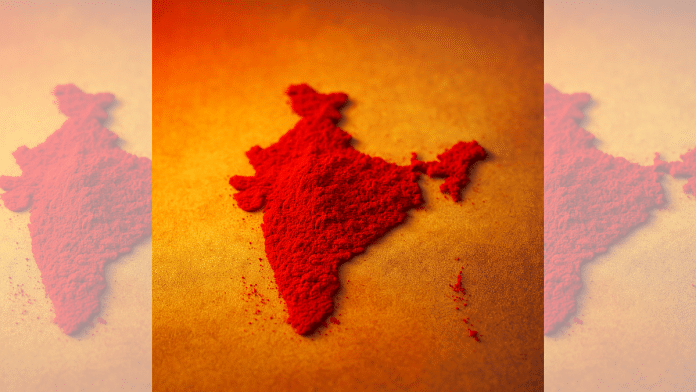Thank you dear subscribers, we are overwhelmed with your response.
Your Turn is a unique section from ThePrint featuring points of view from its subscribers. If you are a subscriber, have a point of view, please send it to us. If not, do subscribe here: https://theprint.in/
On 7 May 2025, India’s Armed Forces launched Operation Sindoor, a pre-dawn strike on nine militant camps in Pakistan and Pakistan-occupied Kashmir. Dubbed “Sindoor”—the sacred vermilion powder that marks a married woman’s vow of protection—the operation embodied what analysts called a Crimson Covenant: a pledge to defend citizens under the ancient principle of dharma (righteous duty). As the Bhagavad Gītā declares, “Yadā yadā hi dharmasya glānir bhavati…” (“Whenever there is decline of dharma…”; Gītā 4.7), so must the state act to restore moral order.
The trigger was the 22 April massacre at Pahalgam, where militants of The Resistance Front forced 26 pilgrims—mostly Hindu devotees—to recite the Kalima before executing them. This sectarian atrocity shattered months of calm and compelled National Security Adviser Ajit Doval to convene an emergency Cabinet Committee on Security within hours. Drawing on satellite imagery, intercepted communications and human-intelligence reports, planners identified nine high-value camps in Punjab and PoK. Legal advisers vetted each site under international humanitarian law and India’s rules of engagement to ensure a lawful, proportionate response.
Over the next four days, what might have been a routine military reprisal was transformed into an exercise in ethical warfare. Notices to Airmen rerouted civilian flights; medical teams were placed on standby at border hospitals; and diplomats in Washington, Moscow and Beijing were briefed. By naming the mission Sindoor, New Delhi cast its military intent as a solemn vow rather than raw retaliation. This civilisational framing drew on Vedic injunctions—“Ahimsa paramo dharmah” (“Non-violence is highest dharma”; Mahabharata)—to underline that force, if necessary, must remain bound by moral discipline.
At 01:05 hrs IST on 7 May, BrahMos and Prithvi missiles struck with sub-metre precision, obliterating fortified bunkers. Simultaneously, Heron and Predator drones provided live battle-damage assessments and, where warranted, employed precision-guided munitions to prevent escape. Special Forces teams stood ready to infiltrate impact zones and verify target destruction, gathering forensic evidence to uphold public accountability. Encrypted datalinks linking the Air Force, Army and RAW allowed commanders to retask follow-on munitions in real time, ensuring that every objective fell within 23 minutes.
Indigenous technology lay at the heart of the operation. DRDO-developed seekers, electronic-warfare suites and secure communications—products of the “Make in India” initiative—performed without fault. NSA Doval hailed the mission as “a showcase of our R&D excellence.” Yet technological prowess never eclipsed ethical restraint: a 500-metre civilian buffer was rigorously observed, and post-strike satellite imagery—corroborated by Human Rights Watch—confirmed zero civilian casualties and no damage to non-military infrastructure on either side of the Line of Control. By 01:28 hrs IST, forces had withdrawn, and Doval challenged critics: “Not even a glass pane was broken on our side.”
Pakistan’s Inter-Services Public Relations swiftly released images alleging civilian damage near Lahore and Islamabad lodged a protest at the United Nations Security Council. New Delhi responded with a proactive information campaign: declassifying high-resolution missile-trajectory maps, publishing flight-log data to affirm that no civilian aircraft entered strike corridors, and sharing unedited drone footage alongside Special Forces after-action reports. This transparency neutralised much of Pakistan’s counter-narrative and earned private commendation from Western capitals, while China’s muted public reaction spoke volumes.
Back in India, public confidence surged as recent polls indicated a significant uptick in approval for the government’s security leadership. Editorials championed what they termed “dharma deterrence,” arguing that ethical restraint itself can serve as a powerful strategic asset. Security experts, however, cautioned that kinetic strikes must be complemented by enhanced border surveillance and community-level counter-radicalisation to forestall proxy retaliation, emphasising that dharma demands sustained vigilance as well as decisive action.
By 10 May, a mutually observed ceasefire brought the four-day flash conflict to a close. Strategists drew five enduring lessons from Operation Sindoor. First, democracies can compress decision-cycles by institutionalising inter-agency fusion centres, mirroring the unity of purpose extolled in the Upanishads. Second, surgical precision must be wedded to principle, making civilian protection a non-negotiable metric. Third, information dominance—through pre-emptive release of evidence—can defuse adversary propaganda. Fourth, cultural resonance, by invoking civilisational symbols such as sindoor and Gītā verses, can galvanise public morale. Finally, Operation Sindoor set a fresh norm in counter-terrorism, proving that modern military engagement can—and should—adhere to dharma-yuddha (righteous warfare).
As the Bhagavad Gītā counsels Arjuna to fight when duty demands, but always in accordance with dharma, Operation Sindoor demonstrated that even in the crucible of conflict, the “fire of dharma” can guide action. By fusing surgical precision with ancient ethical precepts, India has charted a blueprint for future engagements: swift, exacting and governed by the enduring light of righteous duty.
These pieces are being published as they have been received – they have not been edited/fact-checked by ThePrint.


